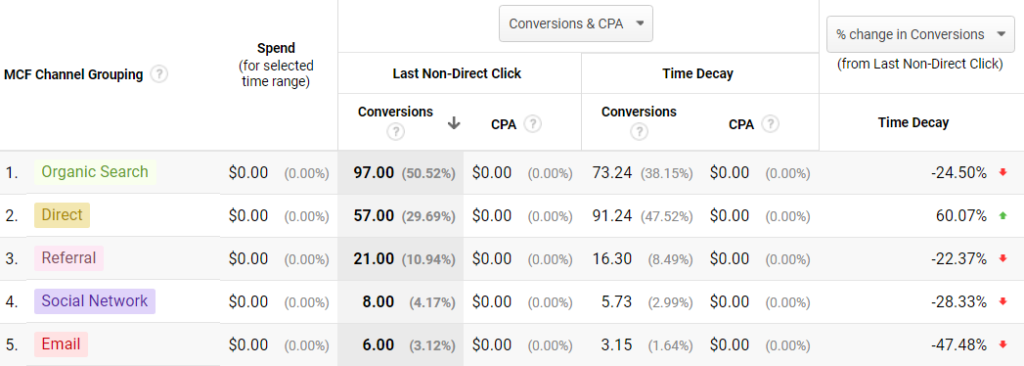Understanding where and why your users convert is important. Each and every user journeys through different channels and interacts with your brand both on- and offline before making a final decision. In this post, you’ll learn all about Google’s attribution models and how they can impact your marketing strategy.
Under the default Google attribution model (Last Non-Direct Click), whichever channel a user touches on their last, non-Direct interaction before converting is assigned 100% attribution.
This is okay—but it’s not great. At the very least, this attribution model gives some insight into WHY a user converted. Although it is Google’s default model of choice, there are actually 7 other models of attribution that users can stack against it in the Model Comparison Tool.
Advanced Attribution and the Model Comparison Tool
In Google Analytics, navigate to Conversions > Attribution > Model Comparison Tool. Here you can directly compare these models of digital marketing attribution.
Applying any one of these different models to your data can only be done in the tool. It cannot be be applied to any of the other reports in Google Analytics (so if you think you’ve figured out the perfect model for your business, you will not be able to use that anywhere else in Google Analytics – which makes deriving holistic insights nearly impossible.
Last Interaction Attribution
This attribution model assigns all conversion value to the final touchpoint before a conversion. This model is used by most analytics platforms—Google Analytics is an exception.
This model is hardly informative. Using the example scenario above, Direct would get the full credit. This ignores 3 of the 4 touchpoints this user had! How can you attribute digital marketing value without insight into their full journey?
Last AdWords Click Attribution
In this attribution model, all credit is assigned to the final AdWords click before a conversion.
If your user clicked through an Ad, then came back through Organic Search multiple times, submitted a lead generation form, and then ultimately converted through Email, none of the Organic or Email interactions would receive any credit. This model is generally only useful for ROI of AdWords itself, and neglects the value of all other channels.
First Interaction Attribution
This method of attribution modeling assigns all conversion value to the first click in a user’s journey to eventual conversion.
This is generally useful for companies with few advertising channels, and it helps by identifying which campaign or channel is driving brand awareness for your business. If your company uses a complex marketing strategy that reaches customers through a variety of channels (perhaps over a long sales cycle), this model won’t help identify the true value of your channels.
Linear Attribution
This method of attribution modeling assigns credit to each touchpoint along a customer’s journey to conversion, with each touchpoint receiving equal credit.
Yes, this model lets you see which models are repeatedly driving conversions, but where this model misses the mark is that not all channels are create equal. The whole point of attribution is understanding what’s working best, and where you should be investing more money. It is tough to do this acurately using a linear model.
Time Decay Attribution
In this attribution model, the farther away a touchpoint is from a conversion, the less credit it receives. Therefore, the first click in a user’s journey to converting receives the least credit, and the last click receives the most. Additionally, a half-life for this decay can be selected. The touchpoint that occurs on this half life receives 50% of the credit that the final touchpoint receives.
This model can work well for businesses with longer sales cycles and frequent repeat customers. For instance, Organic Search may have originally brought a user to your website, but it is the email promotional campaign that keep driving that user to come back and shop your sales.
Position Based Attribution
This model assigns conversion credit to touchpoints based on their position in the user’s journey. The first touchpoints and the final touchpoints are both assigned individual credit allocations. All interactions in between these two touchpoints are assigned a combined credit that is then equally distributed among the number of interactions. The default ratio is 40-20-40, which means that the first and last interactions each receive 40% of the conversion credit. If there were two touchpoints in between those two interactions, they would each receive 10% credit (20/2=10).
This model gives significant credit to the channel that first attracted a user and the channel that cemented the sale, and it does not ignore all those interactions in the middle. However, the percentage allocation is subjective and not unique to your individual business. At the end of the day, the first or last channel may not deserve more than double the value of all other initiatives.
Custom Attribution Modelling
Once the above attribution models have been tested, you can customize your own attribution model. Using one of the methods above as a baseline for the model, you can then make decisions on a unique lookback window, user-engagement credit rules, and other custom credit rules.
For instance, a lookback window from 0 to 90 days can be selected; this window should resemble a typical user journey. User engagement helps to assign credit based on page depth or time on site. Page depth is measured by how many pages the user actually clicks through on their journey to conversion. Custom credit rules assign credit to specific interaction types.
Of these available options, Custom attribution is optimal. However, this model still assigns the same predetermined percentages to every customer journey. Even if this setup is unique to your business, no customer journey is alike, thus, no two journeys should be weighted in the same way.
Ready to conquer your marketing attribution demons? Read about Attribution 360, a new Google product that allows for end-to-end user journey measurement, here.
Subscribe to our newsletter to receive monthly digital marketing updates!

